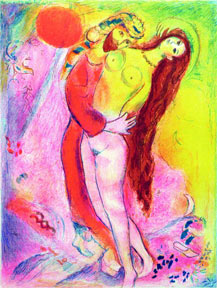Marc Chagall
dal 6/5/2005 al 13/6/2005
Segnalato da
6/5/2005
Marc Chagall
Leslie Sacks Fine Art, Los Angeles
The original suggestion that Chagall should illustrate 'Tales of a Thousand and One Arabian Nights' came from the French publisher Ambroise Vollard in the Twenties, but the artist was well aware that for such an undertaking he would have to master one of the techniques of color printing, since only in that way could he transmute the written language of the tales into his pictorial imagery.

Four Tales from A Thousand and One Arabian Nights
It was almost as if the art world had been waiting for an artist to appear
with the ability, character and background of a Chagall to illustrate the
Arabian Nights in a manner entirely worthy of the tales. A painter was
needed who could handle color so skillfully that the images conjured up in
the reader's mind would be augmented and even surpassed by the visual
images. Yet he also had to be capable of penetrating the language and
imagery of the East and transposing them into a world of pictures
intelligible to Western eyes.
Chagall's art is not bound to any single European tradition or style.
Although he uses color as a means of expression and design he is not an
Expressionist, and although he reduces individual forms to structural
principles he is not a Cubist. Nor can he be included among the naïve or
surrealist painters, even if many of his people and animals are shown
floating in the air and even if he does not obey the laws of proportion or
perspective. Chagall combines the traditions of various cultures in his
pictures, moving freely between East and West, and his creative imagination,
as he himself once said, is "unexpected, Oriental, hovering between China
and Europe." Perhaps this provides the key to the general accessibility of
his art, which requires no erudite interpretation in order to be understood
and which, in its simple pictorial language of the imagination, has
something to say to people of all cultures and backgrounds.
To a certain extent the stories in the Arabian Nights are similar in genesis
to Chagall's pictorial world, as a brief survey of the provenance and
composition of this collection of fairytales shows. We know that the tales
come from a wide variety of cultures  India and Persia, Egypt and
Mesopotamia, Syria and Arabia  and that in the course of centuries they
merged into a single work welded together by the Arabic language and the
Islamic faith. Few people know that many tales deriving from Hebrew culture
also found their way into the collection or that other stories from the
traditions and legends of that culture became so strongly assimilated into
the Islamic-Arabian world that their origin is scarcely recognizable.
Again, long before the Tales of a Thousand and One Nights began their
triumphant progress through the Western world in the first translation, by
the Frenchman J.A. Galland, at the beginning of the eighteenth century, oral
transmission had resulted in the presence of Arabian stories in many
European fairytales. There are, for instance, many parallels between motifs
in the Arabian Nights and in the tales of the Brothers Grimm.
The original suggestion that Chagall should illustrate Tales of a Thousand
and One Nights came from the French publisher Ambroise Vollard in the
Twenties, but the artist was well aware that for such an undertaking he
would have to master one of the techniques of color printing, since only in
that way could he transmute the written language of the tales into his
pictorial imagery. At the time Chagall had no experience of color
lithography. It was only years later, during his exile in the United
States, that in Albert Carman he found a printer with whom he could work on
a successful application of the color lithography technique. The result was
Four Tales from the Arabian Nights, published by Kurt Wolff in 1948 for
Pantheon Books.
Chagall had become interested in the world of fairytales some years before
he started work on the lithographs for the Arabian Nights. This was a
result of his encounter with Igor Stravinsky and the former choreographer of
Diaghilev's Russian Ballet, Leonide Massine, who commissioned him to design
the sets and costumes for Aleko, a ballet by the head of the American Ballet
Theater, Lucia Chase, based on a story by Pushkin and with music by
Tchaikovsky.
The great success of Aleko soon led to further collaboration with the
American Ballet Theater, and many motifs in the costumes that Chagall
designed in 1945 for Stravinsky's Firebird clearly point to the lithographs
for Four Tales from the Arabian Nights that were to follow shortly after.
The concentrated subject matter of the Arabian Nights illustration inspired
a further intensification of the magnificent coloring and the mystical light
of the Orient that had pervaded the ballet, making Chagall's first attempt
at color lithography a particularly splendid jewel in the crown of his
graphic work.
Leslie Sacks Fine Art
11640 San Vicente Blvd. (Brentwood) - Los Angeles



